The iPhone 5 Review
by Anand Lal Shimpi, Brian Klug & Vivek Gowri on October 16, 2012 11:33 AM EST- Posted in
- Smartphones
- Apple
- Mobile
- iPhone 5
Battery Life
Section by Anand Shimpi
At the start of our iPhone 4S battery life analysis I mentioned that I wasn't happy with the current state of our battery life benchmarks. The first incarnation of our smartphone battery life suite was actually a port of what I created to test battery life on Mac notebooks years ago. The Mac suite has evolved over time, and we've made similar evolutions to the smartphone suite - just on a less aggressive pace. The data on the previous page showed just how good Apple is at driving down idle power consumption, and through some software optimization it got very good at winning in our battery life tests. The data was accurate, but stopped being representative of reality.
Going into the iPhone 5 review I knew we needed to change the suite. After testing a number of options (and using about 16.5GB of cellular data in the process) we ended up on an evolution of the battery life test we deployed last year for our new tablet suite. The premise is the same: we regularly load web pages at a fixed interval until the battery dies (all displays are calibrated to 200 nits as always). The differences between this test and our previous one boil down to the amount of network activity and CPU load.
On the network side, we've done a lot more to prevent aggressive browser caching of our web pages. Some caching is important otherwise you end up with a baseband test, but it's clear what we had previously wasn't working. Brian made sure that despite the increased network load, the baseband still had the opportunity to enter its idle state during the course of the benchmark.
We also increased CPU workload along two vectors: we decreased pause time between web page loads and we shifted to full desktop web pages, some of which are very js heavy. The end result is a CPU usage profile that mimics constant, heavy usage beyond just web browsing. Everything you do on your smartphone ends up causing CPU usage peaks - opening applications, navigating around the OS and of course using apps themselves. Our 5th generation web browsing battery life test should map well to more types of smartphone usage, not just idle content consumption of data from web pages.
As always we test across multiple air interfaces (3G, 4G LTE, WiFi), but due to the increased network load we actually find that on a given process technology we see an increase in battery life on faster network connections. The why is quite simple to understand: the faster a page is able to fully render, the quicker all components can drive down to their idle power states.
The downside to starting with a new battery life test is that we don't have a wealth of older data to compare to. I did my best to run whatever we had access to at the time, but there simply aren't that many devices in these charts compared to our older ones. The data below may not look like a lot, but it's the result of running over 300 hours of battery life tests to not only understand how these devices do under load but also to find out the best test to use as the cornerstone of our new suite.
We'll start the investigation on WiFi. Where supported we used 5GHz 802.11n, otherwise 2.4GHz:
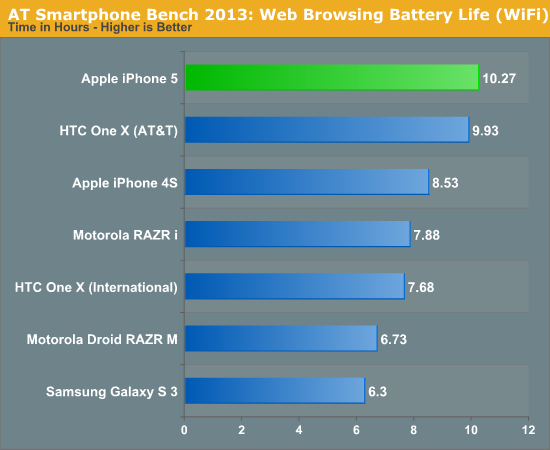
The iPhone 5 manages to match Apple's estimates, just breaking the 10 hour barrier. HTC's One X based on the Snapdragon S4 comes very close however. Although the One X is equipped with a larger battery, it also has a bigger screen and slightly more power hungry SoC to feed as well.
The iPhone 4S is measurably worse here. Keep in mind that the workload between all of the devices here is constant, if you use the faster performance on the iPhone 5 to browse more web pages or use your apps quicker then you may not see an improvement here. Worst case, you may even see a regression in battery life. That's the downside to this increased dynamic range in power consumption that we've been getting for two generations now.
Although this isn't the place for an Intel/Qualcomm comparison, it is important to note that the Atom Z2460 based RAZR i manages to last 17% longer on a single charge than the nearly identical, but Qualcomm S4 based RAZR M.
Next let's look at battery life when we switch to the cellular networks:
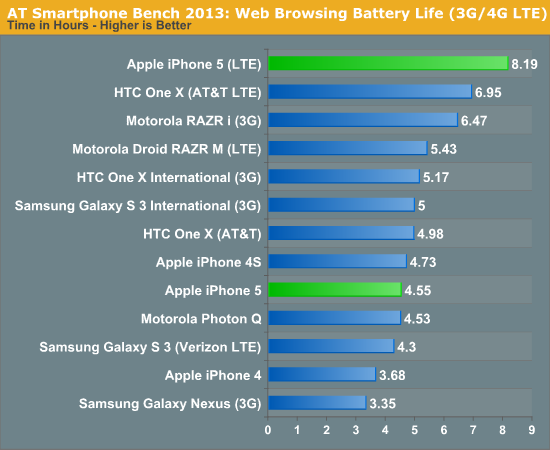
The non-LTE phones see a sharp drop in battery life. At least at 28nm the slower air interfaces simply have to remain active (and drawing power) for longer, which results in measurably worse battery life. Again, the thing to be careful of here is there's usually a correlation between network speed and how aggressive you use the device. With a workload that scaled with network speed you might see closer numbers between 3G and 4G LTE.
HTC's One X continues to do very well on LTE, coming the closest to the iPhone 5. I believe what we're seeing here is really Apple's idle power management building up a small but tangible advantage.
On 3G the iPhone 5 actually dies slightly quicker than the iPhone 4S, although run to run variance can cause the two to flip around in standings. Our iPhone 4 datapoint featured an older battery (both the 4S and 5 batteries were < 30 days old) so it's unclear how a brand new 4 would compare.
The RAZR i does quite well here on 3G. Despite being on a slower network, Intel's platform appears to do a good job of aggressively pushing down to idle. Once again Intel maintains about a 19% battery life advantage over the S4 based RAZR M. The RAZR i and the HTC One X do better than the iPhone 5 on 3G, which supports our theory of idle power consumption being a big reason the iPhone 5 does so well on faster networks.
While our new web browsing battery life tests do a good job of showing the impact of network, display and CPU on battery life, they do little to stress the GPU. Thankfully our friends at Kishonti gave us a shiny new tool to use: GLBenchmark 2.5.1 features a GPU rundown battery life test. The standard tests run Egypt and Egypt HD indefinitely until the battery life dies. We standardized on using Egypt HD at the device's native resolution with a 30 fps cap. All of the displays were calibrated to 200 nits as usual.
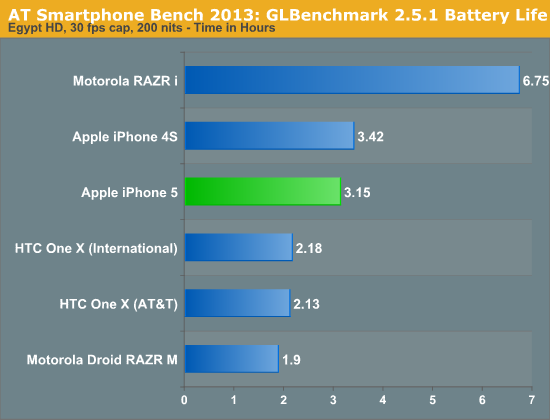
Here the iPhone 4S has a tangible advantage in battery life over the 5. The move to 32nm can only do so much, with many more transistors switching at a higher frequency the A6 SoC ends up drawing tangibly more power than the A5 in the iPhone 4S and delivers a shorter run on battery. The gap isn't huge (the 5 delivers 92% of the battery life of the 4S), but it's still a regression. The iPhone 5 does comparatively quite well here, despite being faster it's able to outlast the S4 and Tegra 3 based devices. The explanation is rather simple: capped to only 30 fps the iPhone 5's GPU likely has the ability to drop down to an idle state for a brief period in between rendering frames. The other devices can't hit 30 fps in this test and as a result have to run at full tilt throughout the entire benchmark. The RAZR i is the only exception to the rule, but it is considerably slower than everything else here (averaging below 8 fps) which could explain the very high result.
Moving on we have our WiFi hotspot test, which measures how long the device can last acting as a hotspot for a wirelessly tethered notebook. Our wireless hotspot test is entirely network bound by its definition. Here I'm including two sets of results, our most up to date LTE hotspot battery life tests as well as the chart we included in our latest iPad review. In both cases the iPhone 5 does relatively well, lasting just over 5 hours as an LTE hotspot on a single charge. In these tests, devices with significantly larger batteries come in very handy.
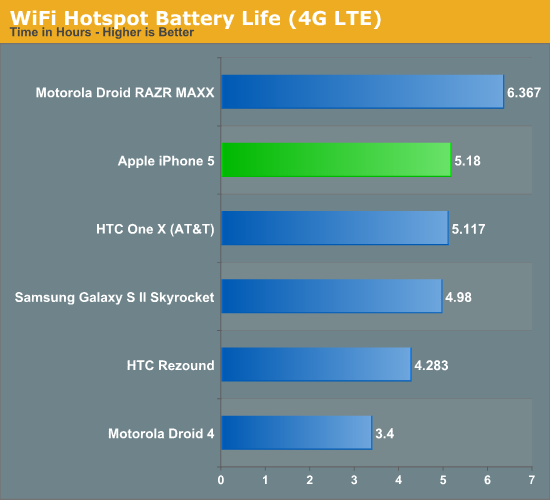

Our final battery life test is our standard call time test. In this test we're playing audio through two phones (one of which is the phone being tested) and measure the call time until the battery is completely drained. The display is turned off, simulating an actual call.
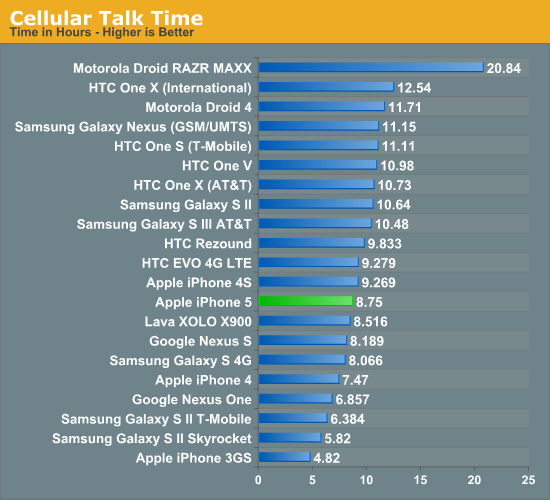
The iPhone 5 falls just short of the 4S in our call time test. There's really no major improvement here as far as we can tell, although it's not clear how much additional work the iPhone 5 is doing with its additional noise cancelling features. If talk time is of the utmost importance to you, you'll want to look at some of the phones with much larger batteries. The Droid RAZR MAXX remains the king of the hill as far as talk time is concerned.
Battery Life Conclusions
If we take a step back and look at the collection of results from our battery life tests, the iPhone 5 can last anywhere between 3.15 and 10.27 hours on a single charge. Do a lot of continuous data transfers and you'll see closer to 5 hours, but if you've got reasonably periodic idle time you can expect something in the 8 - 10 hour range. In short, if you use your device a lot, don't be too surprised to see it lose about 10 - 15% of its battery life for every hour of use.
Now the question is how does the iPhone 5 compare to other devices? Compared to previous iPhones, the 5 has the ability to use a lot more power. If you're doing the exact same, finite length CPU/network intensive task on the iPhone 5 and any previous iPhone, chances are that the iPhone 5 will be able to complete the task and get to sleep quicker - thus giving you a better overall energy usage profile. Where things get complicated is if you use the faster CPU, GPU and network connectivity to increase your usage of the device. In that case you could see no improvement or even a regression in battery life.
Compared to other modern platforms the iPhone 5 should be competitive in day to day power usage, even compared to devices with somewhat larger batteries (~7Wh). The trick to all of this of course is whatever performance advantage that the iPhone 5 has coupled with lower idle power. Being able to complete tasks quicker and/or drop to aggressively low idle power states are really the only secret to the iPhone's battery life.
I feel like the days of ever increasing smartphone battery life are behind us. Instead what we'll likely see going forward is continued increase in dynamic range. Battery life could be better or worse and it'll likely depend heavily on your workload. Much like how we saw notebooks cluster around the same 2 - 5 hour battery life for years, I suspect we'll see something similar here with smartphones. The major difference this time around is the burden of a really large battery isn't as big as it is in a notebook. The RAZR MAXX is the perfect example of a still very portable smartphone that comes equipped with a huge (by today's standards) battery.










276 Comments
View All Comments
medi01 - Wednesday, October 17, 2012 - link
1) Compare ipad2's gamut, cough2) Check values on toms
http://media.bestofmicro.com/3/4/331888/original/g...
http://www.tomshardware.com/reviews/ipad-3-benchma...
Unlike anand, toms was beyond primitive contrast/brightness benchmarking for quite a while.
thunng8 - Thursday, October 18, 2012 - link
Not sure if I should trust Tom's figures compared to Anands's.In any case, both show the ipad3 has higher gamut, especially in sRGB.
steven75 - Wednesday, October 17, 2012 - link
I think what you meant to say is that AMOLEDs win on black levels and that's about it. LCDs still win in accuracy and most importantly ability to see them in outdoor settings.KoolAidMan1 - Tuesday, October 16, 2012 - link
Not even close. Even the better Android displays like the Galaxy S3 has a PenTile display. Despite having more "pixels" it actually has fewer subpixels than the iPhone does. Unless you have bad eyesight the S3 display looks really bad in comparison, and this is before we get to even worse smartphone displays out there by HTC, etc.Sufo - Tuesday, October 16, 2012 - link
Old pentile displays were visibly jaggy on vertical lines - even my old lumia 800 exhibited this to some extent. On the GS3 tho, it is not noticeable and it has nothing to do with eyesight.Your comment makes it sound (to someone who has seen many different smartphone displays in person) as though you haven't spent much time with the GS3 (read: many smartphones) at all. Simply mentioning that is uses pentile subpix config, from you, sounds like regurgitated information. Not only that, but you seem to gloss over the many benefits that amoled panels bring. It's arguable that these benefits are more important than an accurate colourspace on (specifically) a mobile phone - although it is ofc entirely subjective.
This brings me to the last tell of ignorance I noted; your mention of HTC. Have you used a One X? For those who do not like amoled panels, the display on the one x is perhaps nicer than both the gs3 and the ip5. Ofc you may say Android is not your cup of tea, and that's a perfectly justifiable stance, however it has nothing to do with display tech.
tl;dr You sound like you don't know what you're talking about
KoolAidMan1 - Tuesday, October 16, 2012 - link
I do know what I'm talking about given that I've seen many smartphones, and I've calibrated my share of desktop displays to sRGB.Differences in display tech aside, Android phones have never gotten color profiles right, EVER. They're almost always oversaturated, have too much contrast, and are inaccurate. Anand even posted a difference in color accuracy between several devices, and the profile for the S3 is totally what I expected.
The S3 really doesn't look good, period, but then again there are people who argue that TN panels are just fine against IPS. I'm used to hearing nonsense on forums when it comes to display from people who don't know what to look for.
KoolAidMan1 - Tuesday, October 16, 2012 - link
BTW, apologies if that came out harsh, but the difference in color and contrast accuracy between something like the S3 and a properly calibrated device is a night and day difference to me. I'm pretty sensitive to display quality though; my main desktop display at home is still an NEC and my plasma is a Pioneer Elite (RIP)rocketbuddha - Tuesday, October 16, 2012 - link
For Android you have the following 720p HD DisplaysSLCD - HTC Rezound (2011 tech)
SLCD 2 - HTC One X, Sony HD
HD SAMOLED Pentile - GS3, Galaxy Nexus, Moto Razr HD
HD SAMOLED RGB - Galaxy Note II
True IPS LCD - LG Optimus 4X, Optimus G
Super IPS LCD -Asus Padphone, Sharp phones etc
So you have big set of choices. If dark contrasts are important then SAMOLED is the way to go. SAMOLED RGB over SAMOLED Pentile.
If overall color and whites are important go with SLCD2.
IPS LCDs are the closest to the Retina Display and u have a choices there too. You can pick and choose what is good for you and have alternatives.
Spunjji - Thursday, October 18, 2012 - link
The HTC One X has what is hailed to be one of the best LCD smartphone displays out there. Your claim is invalid.Similarly, the Galaxy Note 2 has an AMOLED display without PenTile. Sure, it's lower density, but one does not hold a 5.5" screen so close to one's face.
medi01 - Wednesday, October 17, 2012 - link
""The iPhone 5 display is better than any current Android display.""Why don't you go hit your dumb head with something heavy, ipad would do?